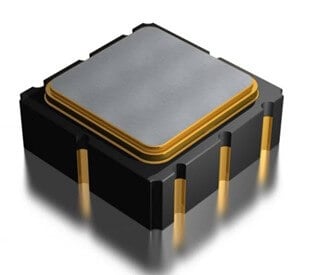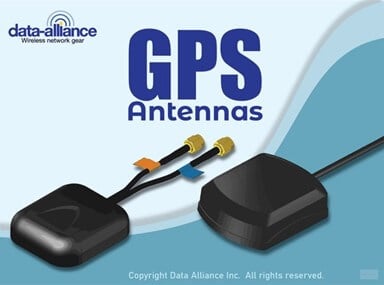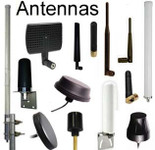Antennas, Antenna Cables, Wireless Products: Technical Articles
SAW filters for GPS Antennas - Surface Acoustic Wave
Table of Contents
SAW Filters for GPS Antennas:
SAW filters are a key addition to the radio frequency front end of GPS devices and help ensure that while receivers are sensitive they can retain specificity by separating and rejecting unwanted signals and interference. This short article explains what SAW filters are and the use in GPS devices.
Data Alliance’s GPS antennas all include a SAW filter, including our GPS combo / combination antennas that are GPS combined with LTE and/or WiFi.
What is a SAW filter?
Surface Acoustic Wave (SAW) Filters are specialist electronic devices that are capable of filtering radio frequency signals. This means that they are either permeable to or capable of blocking, RF signals of a specific frequency.

SAW filters typically perform their filtering action by absorbing radio frequency energy and converting it into either acoustic or mechanical energy by using piezoelectric materials such as quartz, lithium niobate (LiNbO3), or lithium tantalite (LiTaO3). The exchange of energy takes place in a component called an Interdigital Transducer (IDT) that contains an array of electrodes that convert the electricity, generating Surface Acoustic Waves. These Surface Acoustic Waves then travel across the piezoelectric material which converts the energy back into electrical energy for dispersal.
SAW filters are compact and cost-effective units that are manufactured for a range of applications. SAW filters are typically used for microwave frequencies up to a maximum of 3 GHz, with the selectivity of the filter gradually declining at frequencies above 1.5 GHz. A SAW filter will have a center frequency but its efficacy and specificity can be affected by environmental conditions such as temperature. Non-Temperature Compensated (TC) filters often experience an increase in center frequency at lower temperatures and a decrease in center frequency at higher temperatures.
SAW filters for GPS devices and applications:
A GPS filter is a type of SAW filter that is used to filter out signals that interfere with GPS, enhancing the reception and overall performance of a receiver. They are usually Surface-Mounted Technology units and designed to pass only a specific frequency (e.g. 1575 MHz L1).
A typical SAW GPS filter will deliver a 20 MHz bandwidth around its center frequency, meaning that an L1 Filter that has a center frequency of 1575 MHz will have a passband of 1565 to 1585 MHz. The filter will reject interference and unwanted signals at 10 dB at 1525 MHz and at 1625 MHz the rejection will be 22 dB. Depending on the manufacturer, example insertion losses and return losses for a SMT GPS filter can be around 0.9 dB and 14 -dB respectively.
GNSS receivers are already capable of processing received signals to remove unwanted elements and amplify the satellite-based signals. Part of the process of acquiring a GPS “fix” is separating the GPS signal with a code that is present in the GPS satellite broadcast.
However, the presence of radio frequency interference causes the Time To First Fix (TTFF) to be delayed. The interaction of the GPS broadcast signal with the ionosphere and atmosphere it passes through on the way to the receiver can produce distortions and delays. A GPS filter separates out these unwanted frequencies and makes the true signal clearer.
GPS receivers require specificity as well as sensitivity.

GPS receivers have to be sensitive because the GPS signal suffers significant attenuation as it travels to earth. Low Noise Amplifiers (LNAs) are routinely used with GPS receivers to increase signal reception.
However, this makes the receivers vulnerable to the effects of electromagnetic interference from a variety of sources which can impair the device’s ability to lock onto a clear signal. Multimode devices which have numerous wireless technologies operating simultaneously may experience jamming and coupling from cellular signals can also be disruptive.
A SAW filter, placed in front of the LNA helps protect against the effects of such noise as it will be efficiently filtered and rejected. GPS SAW filters make a GPS system more reliable, especially where interference is regularly encountered. In urban areas, or where a GPS antenna is located close to transmitting antennas they are especially advantageous. They require competent installation to ensure that only the center frequency is allowed through.
Managing insertion losses from SAW filters.
The weakness of GPS signals means that insertion loss from the inclusion of a SAW filter on the receiver’s RF line can be significant. The decision to include a SAW filter must balance these receiver chain insertion losses against the rejection of out-of-band signals that can be achieved.
The type of SAW filter used may affect insertion losses.
- SAW filters with Interdigital Transducers (IDTs) have electrodes that project perpendicular to the direction of propagation of the surface acoustic wave. This geometric arrangement is known to limit the performance of the filter, particularly by limiting its maximum bandwidth. The number of finger electrode pairs in an IDT has an inverse relationship with the fractional bandwidth of the filters. Larger bandwidth filters will have few IDT fingers but this leads to the generation of bulk waves and a significant rise in filter insertion loss.
- Slanted Finger Interdigital Transducer (SFIT) filters are a type of SAW filter used in GPS applications that have lower insertion loss compare to the convention IDT design. They have a greater density of electrodes, due to their slanted orientation, meaning that they can also achieve a small shape factor.
The type of piezoelectric material and its preparation can also affect the insertion losses of a SAW filter.
The position of a SAW filter in the receiver line also affects performance.
SAW filters are typically used in series with an LNA. Positioning the filter before the LNA input can prevent the LNA from becoming saturated with high-power jamming signals and enhance its selectivity for the target frequency. GPS filters can also be positioned after the LNA to suppress EMI and unwanted signals that may couple to the line.
Superior protection for mission-critical GPS applications
SAW filters are a critical enhancement to GPS receivers used in emergency settings where the performance of GPS devices needs to be reliable and robust. SAW filters have been demonstrated to out-perform ceramic filters and LC filters, making them a routine addition to GPS receivers deployed in challenging settings.
Conclusion:
SAW filters play a crucial role in enhancing the reliability and accuracy of GPS receivers by filtering out interference while preserving the desired satellite signals. Though they introduce some insertion loss, their ability to protect sensitive GPS systems from electromagnetic noise and jamming makes them indispensable—especially in multimode devices and challenging environments. By improving signal clarity and reducing time to first fix, SAW filters ensure GPS antennas deliver consistent, mission-critical performance.
FAQs
What is a SAW filter and how does it work?
A Surface Acoustic Wave (SAW) filter is an electronic device that filters radio frequency (RF) signals by converting them into acoustic energy using piezoelectric materials such as quartz or lithium niobate. It then reconverts the energy into electrical form, allowing only specific frequencies to pass while blocking unwanted signals.
Why are SAW filters important for GPS antennas?
GPS signals are very weak when they reach Earth and can be easily disrupted by interference. SAW filters help ensure GPS receivers remain both sensitive and selective by filtering out unwanted frequencies, improving accuracy, and reducing delays in acquiring a GPS fix.
What frequency range do GPS SAW filters typically cover?
Most GPS SAW filters are designed for the L1 frequency band at 1575 MHz, with a typical bandwidth of around 20 MHz (1565–1585 MHz). They allow the desired GPS signals to pass while rejecting interfering signals outside this range.
Do SAW filters affect GPS signal strength?
Yes, SAW filters can introduce insertion loss, which slightly weakens the GPS signal. However, the benefits of rejecting strong out-of-band interference usually outweigh the small signal reduction. Advanced designs, such as Slanted Finger Interdigital Transducer (SFIT) filters, help minimize insertion losses.
Where should a SAW filter be positioned in a GPS receiver?
A SAW filter is typically placed before the Low Noise Amplifier (LNA) to prevent strong interfering signals from saturating the amplifier. It can also be placed after the LNA to further reduce electromagnetic interference (EMI).
How do environmental conditions affect SAW filter performance?
Temperature changes can shift the center frequency of SAW filters. Non-temperature-compensated filters may increase frequency at lower temperatures and decrease at higher ones, which can affect precision in certain conditions.
In what situations are GPS SAW filters especially beneficial?
They are particularly valuable in urban areas, near transmitting antennas, and in multimode devices that combine GPS with LTE, WiFi, or other wireless technologies. In mission-critical applications, such as emergency services, SAW filters greatly improve GPS reliability and signal clarity.







